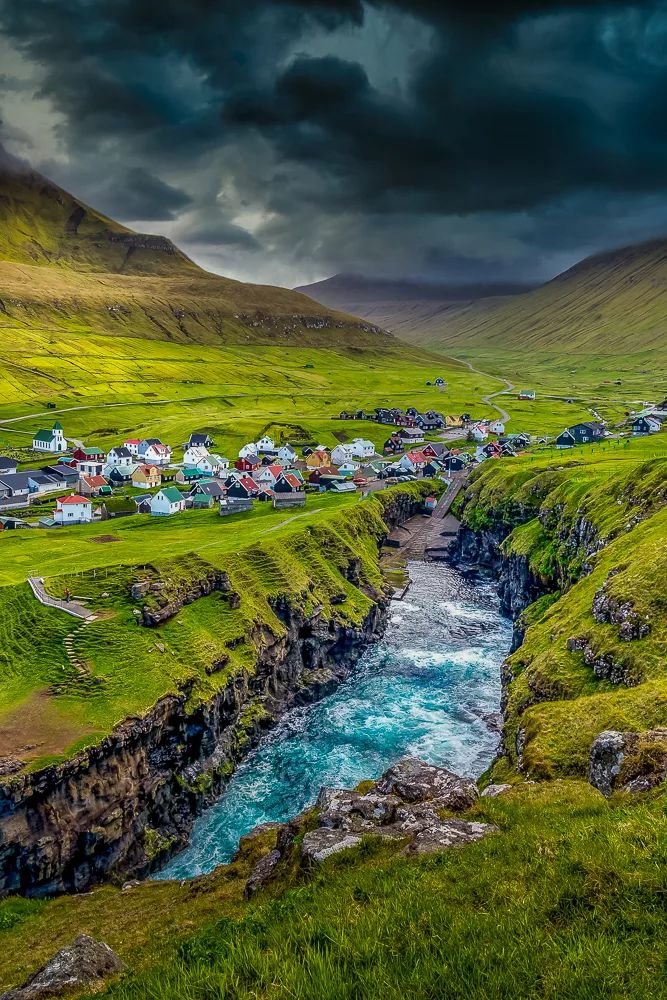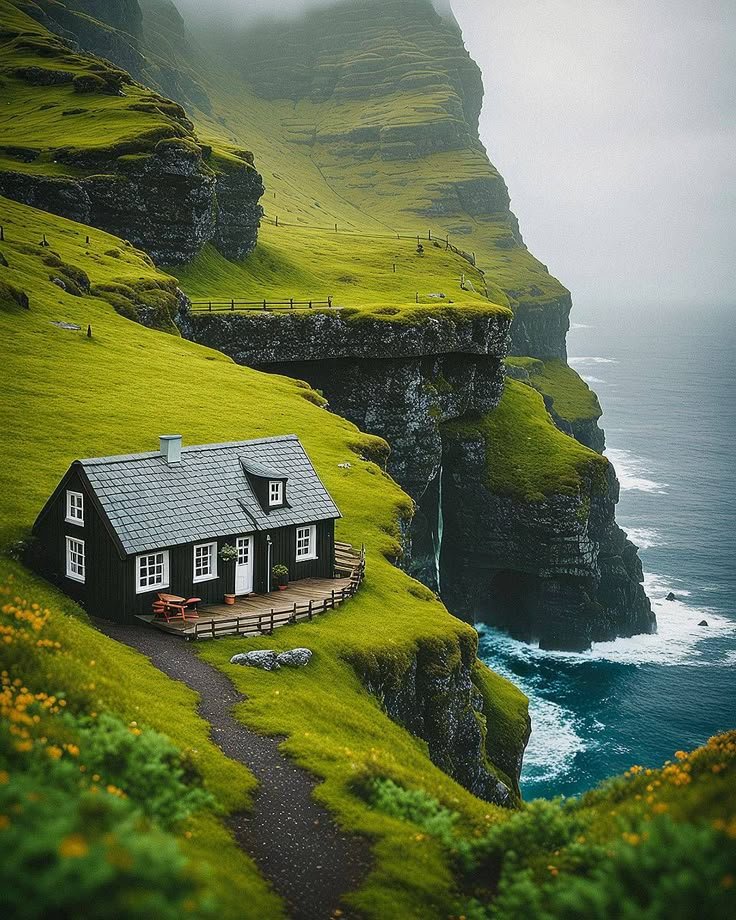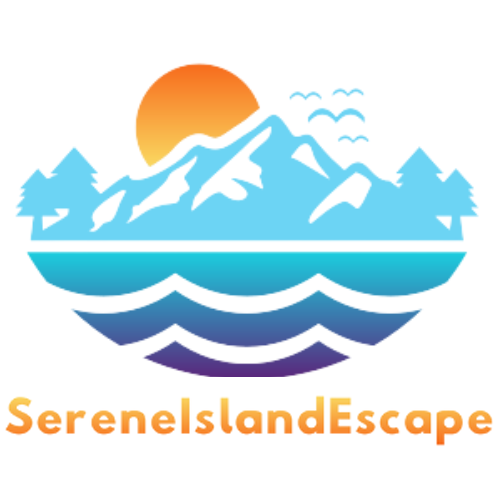Nestled between Iceland and Norway in the North Atlantic Ocean, the Faroe Islands represent one of Europe’s most captivating yet overlooked destinations. If you’re wondering how to go to Faroe Islands, you’ve discovered a remarkable travel opportunity. This autonomous territory of Denmark boasts dramatic landscapes featuring towering sea cliffs, cascading waterfalls, and charming villages with colorful grass-roofed houses. The archipelago’s 18 volcanic islands connected by tunnels, ferries, and bridges offer an escape into pristine nature that feels worlds away from mainstream tourism. If you’re yearning for breathtaking vistas, authentic cultural experiences, and adventures off the beaten path, planning a journey to this Nordic paradise should be high on your travel wishlist.
Planning Your Journey to the Faroe Islands
Before diving into the specifics of how to go to Faroe Islands, it’s important to understand what makes this destination so special. The islands offer a perfect blend of dramatic natural beauty, rich cultural heritage, and modern infrastructure that makes travel accessible while maintaining an authentic experience. Whether you’re an avid photographer, hiking enthusiast, or cultural explorer, the Faroe Islands provide experiences that will create lasting memories.
How to Reach the Faroe Islands
The remoteness of the Faroe Islands adds to their charm, but reaching this North Atlantic gem requires some strategic planning. Fortunately, despite their seemingly isolated position, these islands are more accessible than many travelers realize, with both air and sea options available depending on your preferences, budget, and sense of adventure.
- Direct flights to the Faroe Islands operate year-round from Copenhagen, Denmark via Atlantic Airways (the national carrier) and SAS, with the journey taking approximately 2 hours and offering stunning aerial views of the archipelago during descent.
- Seasonal direct flights connect the Faroe Islands with destinations including Edinburgh, Bergen, Reykjavík, Paris, and Barcelona, providing convenient options for travelers already exploring other parts of Europe who wish to include this unique destination in their itinerary.
- The passenger and car ferry Norröna, operated by Smyril Line, sails weekly from Denmark and Iceland to Tórshavn (the Faroese capital), offering a scenic multi-day sea journey that allows you to bring your own vehicle—ideal for travelers planning an extensive exploration of the islands.
- Vágar Airport, the Faroe Islands’ only airport, is located on Vágar Island approximately 45 minutes by car from Tórshavn, with airport buses coordinated with flight arrivals to transport visitors to the capital and other major settlements.
- When booking flights, consider the shoulder seasons (May-June or September-October) for potentially lower airfares while still enjoying reasonable weather conditions for exploration and photography.
Best Time to Visit the Faroe Islands
The Faroe Islands experience a cool, maritime climate characterized by mild winters and cool summers, with weather that can change dramatically throughout a single day. Understanding the seasonal variations will help you select the optimal time for your visit based on your interests, preferred activities, and tolerance for various weather conditions.
- Summer months (June to August) offer the longest daylight hours with up to 19-20 hours of daylight around the summer solstice, creating almost endless opportunities for exploration and photography with the islands’ famous “golden hour” light extending well into the evening.
- The period between mid-May and mid-July provides the best chance to observe the iconic puffins that nest along the islands’ cliffs, particularly in locations such as Mykines island where thousands of these charismatic seabirds return annually to breed.
- Spring (April-May) brings vibrant green landscapes as the islands emerge from winter, with fewer tourists than summer and the opportunity to witness lambing season—a significant event in the agricultural calendar of this sheep-farming society.
- Autumn (September-October) bathes the islands in golden hues as the vegetation changes color, while offering opportunities for visitors to experience traditional Faroese activities such as the community sheep round-ups known as “réttir.”
- Winter (November-March) presents the islands in their most dramatic state with powerful North Atlantic storms, significantly shorter daylight hours, and the possibility of witnessing the Northern Lights, though travelers should be prepared for potentially disrupted transportation due to weather conditions.
Essential Documents and Preparations
Preparing appropriately for your journey to the Faroe Islands involves understanding entry requirements, packing suitable clothing, and making certain practical arrangements to ensure a smooth and enjoyable experience in this remote North Atlantic destination.
- For travelers from the EU, EEA, and Switzerland, only a valid national ID card is required to enter the Faroe Islands, while visitors from other countries including the UK, US, Canada, and Australia need a passport valid for at least three months beyond their intended stay.
- The Faroe Islands are not part of the Schengen Area, but they follow Denmark’s visa policy, meaning that if you need a visa to enter Denmark, you will also need one to visit the Faroe Islands—check with the Danish embassy or consulate in your country well in advance of your planned trip.
- Pack layers of clothing regardless of the season, including quality waterproof and windproof outer layers, sturdy hiking boots with good grip for exploring the often slippery terrain, and a warm hat and gloves even for summer visits when winds can be surprisingly chilly.
- Bring a good quality camera with extra batteries and memory cards to capture the islands’ breathtaking landscapes, as well as binoculars for wildlife spotting, particularly if you hope to observe the diverse seabird populations including puffins, guillemots, and fulmars.
- Consider purchasing travel insurance that specifically covers remote destinations and activities such as hiking, boat tours, and helicopter transfers, with particular attention to coverage for trip cancellation or delay due to weather conditions, which can be a significant factor in this region.

Exploring the Faroe Islands
Once you’ve figured out how to go to Faroe Islands, the next exciting phase is discovering how to navigate and experience this unique archipelago. The islands’ compact size belies the wealth of experiences they offer, from dramatic landscapes to cultural immersion opportunities.
Getting Around the Faroe Islands
Navigating between and across the islands offers its own unique adventure, with a remarkably well-developed transportation network that includes roads, tunnels, ferries, buses, and even helicopters. Understanding your options for getting around will help you make the most of your time and access even the most remote corners of this captivating archipelago.
- Renting a car provides the greatest flexibility for exploring the islands at your own pace, with most major islands connected by an excellent network of roads, bridges, and sub-sea tunnels—just be prepared for narrow, winding routes, single-lane tunnels with passing places, and the possibility of sheep wandering onto the road.
- The public bus network (operated by SSL) offers a surprisingly comprehensive and affordable option for travelers, with routes connecting most major settlements and attractions across the islands, though services may be limited in frequency, particularly on weekends and in remote areas.
- Ferry services connect islands that aren’t linked by bridges or tunnels, with larger car ferries serving main routes and smaller passenger-only vessels accessing more remote islands—schedules vary seasonally, so check the latest timetables on the SSL website when planning your itinerary.
- The helicopter service operated by Atlantic Airways serves as both a lifeline for remote communities and an incredibly scenic (and surprisingly affordable) transport option for tourists, with subsidized fares for residents meaning that tourists can only book one-way journeys, requiring return by boat or bus.
- Consider purchasing the “Complete Journey Card” from SSL if you plan to extensively use public transportation, offering unlimited travel on buses and most ferries for a period of 4 or 7 days, though note that it does not include the sub-sea tunnel tolls or helicopter flights.
Must-Visit Natural Attractions
The Faroe Islands’ dramatic natural landscapes form the archipelago’s greatest draw, with towering sea cliffs, peculiar rock formations, cascading waterfalls, and serene lakes setting the stage for unforgettable outdoor experiences. These natural wonders, sculpted by volcanic activity and millennia of North Atlantic weather, offer visitors the opportunity to connect with some of Europe’s most pristine and powerful environments.
- The iconic Múlafossur waterfall in Gásadalur presents one of the islands’ most photographed scenes as it plunges directly from a cliff face into the ocean below, framed by the small village and surrounding mountains—a site made accessible only in 2004 with the completion of a tunnel through the mountains.
- Lake Sørvágsvatn (also called Leitisvatn), the largest lake in the Faroe Islands, creates a stunning optical illusion where it appears to hover hundreds of meters above the ocean, while in reality the difference is only about 30 meters—the hike to the Trælanípa cliffs provides the perfect vantage point for this remarkable perspective.
- The vertical sea cliffs at Vestmanna on Streymoy Island rise dramatically from the ocean to heights of up to 600 meters, best experienced on a boat tour that navigates through narrow sounds and into sea caves while offering opportunities to observe the rich birdlife that nests along these imposing rock faces.
- Kallur Lighthouse on the northern tip of Kalsoy Island rewards hikers with panoramic views after a moderately challenging trek, featuring spectacular vistas of surrounding islands and the open North Atlantic—the journey to this remote location, involving a ferry and hike, epitomizes the rewarding adventure of Faroese exploration.
- Saksun, a small village set in an ancient amphitheater-like valley with a lagoon that fills and empties with the tides, offers visitors a glimpse into traditional Faroese rural life against a backdrop of mountains, with its turf-roofed buildings and historic church creating a scene that seems frozen in time.

Unique Activities and Experiences
Beyond simply admiring the islands’ natural beauty, the Faroe Islands offer visitors a range of distinctive experiences that connect travelers with the archipelago’s culture, wildlife, and landscapes in meaningful ways. These activities provide opportunities to engage more deeply with this remarkable destination and create lasting memories of your journey.
- Embark on a bird-watching expedition to Mykines, the westernmost island in the archipelago, where thousands of puffins nest during summer months, creating opportunities for close encounters with these charismatic seabirds as they fish in the surrounding waters and tend to their burrows along grassy slopes.
- Experience traditional Faroese chain dancing, a form of ballad singing and dancing dating back to medieval times that continues to play an important role in contemporary Faroese culture, with opportunities to observe or even participate during cultural festivals and community gatherings throughout the year.
- Attend a heimablídni (home hospitality) dinner where local families open their homes to visitors for authentic Faroese meals featuring traditional ingredients such as lamb, fish, potatoes, and fermented specialties, providing not just a culinary experience but also a chance for cultural exchange in an intimate setting.
- Explore the vibrant music scene that has earned the Faroe Islands recognition far beyond their size, with opportunities ranging from attending the world-renowned G! Festival held each July on a beach in Gøta to discovering emerging artists in cozy café venues in Tórshavn or experiencing traditional ballad singing in village settings.
- Take a guided hiking tour with a knowledgeable local who can enhance your understanding of the islands’ geology, flora, fauna, and cultural history while leading you to spectacular viewpoints and hidden locations that might be difficult to discover independently.
Where to Stay and What to Eat
A crucial part of planning how to go to Faroe Islands involves making decisions about accommodation and experiencing the local cuisine. These elements significantly contribute to the overall authenticity and enjoyment of your journey.
Accommodation Options
The Faroe Islands offer an intriguing range of places to stay, from international-standard hotels to highly distinctive local options that enhance the authentic character of your visit. Understanding the various accommodation types and their distribution across the islands will help you plan a comfortable journey while potentially experiencing traditional Faroese hospitality.
- Hotels in Tórshavn provide the most conventional accommodation option, with properties like Hotel Føroyar offering panoramic views over the capital and Hotel Hafnia providing a central location ideal for exploring the historic Tinganes district with its characteristic red buildings and narrow lanes.
- Guesthouses and B&Bs scattered throughout the islands offer more personalized experiences, often in converted traditional houses where hosts provide local knowledge and insights, freshly prepared breakfasts featuring Faroese ingredients, and a more intimate connection to the communities you’re visiting.
- Self-catering cottages and apartments give travelers greater independence and the opportunity to experience life in Faroese villages, many featuring traditional turf roofs and contemporary interiors, providing an authentic setting combined with modern comforts.
- Camping is permitted in designated areas with facilities varying from well-equipped campgrounds with showers and cooking facilities to more basic sites in remote locations, offering budget-conscious travelers the opportunity to immerse themselves in the islands’ natural environment.
- Unique accommodation experiences include staying in converted boathouses along the waterfront in villages like Gjógv, spending nights in remote lighthouses such as the one at Akraberg, or booking rooms in historic buildings like the centuries-old Royal Trade Monopoly warehouses in Tórshavn that have been thoughtfully repurposed as distinctive lodging.
Faroese Cuisine and Food Experiences
Faroese cuisine reflects the islands’ harsh climate and seafaring heritage, with traditional foods developed from methods of preservation and locally available ingredients. Contemporary Faroese gastronomy balances these traditions with modern influences, creating a dining landscape that ranges from humble home cooking to pioneering New Nordic restaurants that have earned international recognition.
- Sample ræst kjøt and ræst fiskur, traditional wind-dried lamb and fish that develop distinctive flavors through a controlled fermentation process in special drying sheds called hjallur, offering visitors a taste of preservation techniques that have sustained islanders through centuries of harsh winters.
- Experience fine dining at KOKS, the Faroe Islands’ two-Michelin-starred restaurant that has brought international attention to Faroese cuisine through its innovative approach to local ingredients, featuring foraged herbs, sustainably caught seafood, and heritage meats prepared with contemporary techniques.
- Visit Heimablídni experiences where local families open their homes for traditional meals, offering dishes such as lamb soup (súpan), potatoes with whale meat (grind og spik), or fish with boiled potatoes and melted sheep tallow in settings that encourage cultural exchange.
- Explore the growing café culture in Tórshavn, where establishments like Paname Café and Brell Café offer excellent coffee alongside traditional Faroese pastries such as drýlur (a type of cinnamon roll) or more contemporary fare incorporating local ingredients like rhubarb, berries, and traditional grains.
- Attend food festivals such as the Fisagil Fish Festival in Klaksvík or seasonal celebrations marking traditions like grindadráp (the controversial but culturally significant whale hunt), where communities gather to prepare and share traditional foods while visitors can observe culinary traditions in their authentic social context.
Practical Travel Tips
Successfully navigating the unique aspects of travel in the Faroe Islands requires some specialized knowledge and preparation. These practical considerations will help you make the most of your visit while respecting local customs and addressing the particular challenges that might arise in this remote destination.
- Download useful apps before arrival, including the Faroe Islands Weather app for hyperlocal forecasts that are essential given the rapidly changing conditions, the SSL (public transport) app for real-time bus and ferry information, and offline maps through platforms like Maps.me as internet connectivity can be inconsistent in remote areas.
- Carry sufficient cash for visits to smaller villages where card payments might not be universally accepted, though credit cards are widely used in larger settlements and tourist facilities—note that the islands use Danish kroner (DKK) with distinctive Faroese designs on notes and coins.
- Respect local environmental practices by staying on marked paths when hiking to protect the fragile vegetation, carrying out all trash, avoiding disturbance to wildlife (especially during breeding seasons), and observing guidelines around responsible tourism that many communities have established as visitor numbers increase.
- Be prepared for shops and many attractions to close on Sundays, reflecting the islands’ strong religious traditions, and plan accordingly with advance purchases of groceries and flexible scheduling of activities—the same applies to public holidays when very limited services may be available.
- Engage respectfully with controversial aspects of Faroese culture such as whaling and sheep farming practices, recognizing that these traditional activities remain important to island identity while being open to learning about how local perspectives may differ from those of visitors.
Embracing the Faroese Experience
The journey to the Faroe Islands offers travelers far more than simply another destination to check off a list—it provides an opportunity to engage with a unique culture deeply connected to its natural environment, to witness landscapes of breathtaking beauty shaped by powerful geological and meteorological forces, and to experience a way of life that has adapted to both the challenges and gifts of this remarkable North Atlantic archipelago.
With thoughtful preparation and an open mind, visitors to the Faroe Islands can discover the profound rewards of slow travel in a destination that invites genuine connection, contemplation, and appreciation for both natural wonders and cultural heritage. Whether you’re traversing mountain paths with views of the endless ocean, sharing stories with locals in a cozy café, or standing at the edge of vertiginous sea cliffs as seabirds wheel overhead, the Faroe Islands offer moments of wonder that resonate long after your journey concludes.
As you plan your adventure to this captivating destination, embrace the uniqueness of the Faroese experience—the changeable weather that creates dramatic lighting effects across the landscape, the peaceful rhythms of island life, and the warm hospitality of a people proud to share their corner of the world. The question is not simply how to go to the Faroe Islands, but how to truly immerse yourself in all they have to offer once you arrive.

